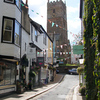
The Butterwalk, Duke Street, with its timber framed arcade was built in 1635-40 with its intricate wooden carvings and a frontage supported on granite columns forming an arcade. The facade was damaged by bombs during 1943, but it has now been fully restored.
Massive dividing walls and intricate wood carvings of cherubs, horses and grotesques reflect the style in use in Brittany and the extensive trade with that region at the time. According to deeds in the Devon Records Office in Exeter, the Butterwalk is built on land reclaimed from the river in 1628. Mark Hawkins, a local fish merchant took a lease on the site in 1629 and in 1635 “built there several dwelling houses”. Hawkins took a mortgage of £2,500 to pay for this and let the houses to tenants in what was in effect a 17th Century ‘buy to let’. Hawkins’ trading activities collapsed when the English Civil War interrupted trade after 1642 and he was unable to pay the interest on the loan. The property was repossessed and the building passed to John Plumleigh in 1653. In 1657 it was sold to John Barnes, who lived there himself. |
|


